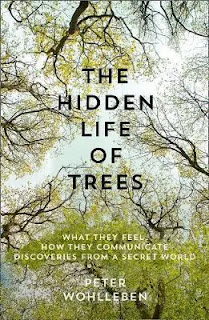I'd always thought of trees as simply things that are there, part of the scenery, and honestly not much different from rocks. But I was wrong; they have a pretty vibrant life, it's just lived at a much slower pace. In many ways, the depiction of Ents in The Lord of the Rings was prescient. It wasn't until I read Jahren's book that I learned that trees communicate threats to other trees. Wohlleben goes into even more detail. Trees in healthy, long-lived forests have a network of fungi in their roots that connect trees--even trees of different species. This "web" can pass information as well as nutrients, so that a tree in a drier location can grow better because of the help it gets from it's neighbors.
Trees are not just inanimate objects, but living beings who react to their environment as well as communicate warnings and distress to others. Trees can "feel" when they are being eaten, and they will pump compounds into their leaves that make them less palatable to leaf-eating bugs and animals. They will also pump compounds into the air that other trees sense, so others can arm themselves before the threat even arrives.
Because human beings are so different from trees, learning about them is more challenging. It is easy to see that trees do not have what we have (brains, mouths, vocal cords) and assume that they are the simplest of creatures. Instead we have to think outside of the box and really dig in with an open mind to discover an entirely new world that we didn't understand. This knowledge makes a big difference in managing forests and understanding the importance of old-growth forests. When we manage forests for lumber and pulp, they lose some of their most important components.
Wohlleben also discusses how trees reproduce, how they deal with drought and climate change, and how they can slowly travel and evolve. I definitely learned some things and now look at trees in a different light. However, I often wanted more information from this book. Some of this comes from my own ignorance. I can name only a few tree species, so most of the time, I only had a vague idea of the kind of trees the book was discussing. In addition, though, I wish the author had explained more about how trees really work and how we know all this about trees. The author sometimes used extremely anthropomorphic language, perhaps to make the trees feel more accessible, but I found it more confusing than helpful.
* I highly recommend this memoir.

No comments:
Post a Comment